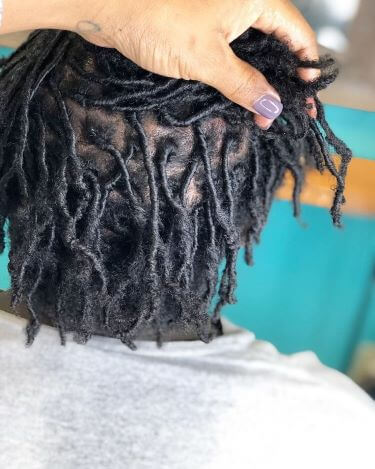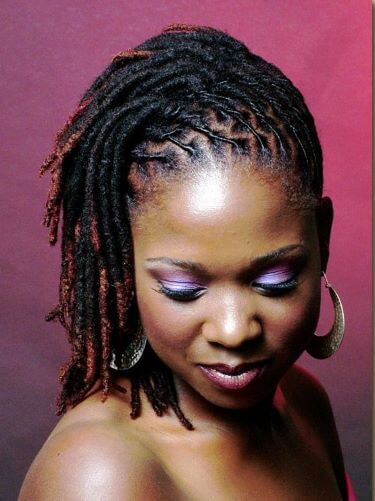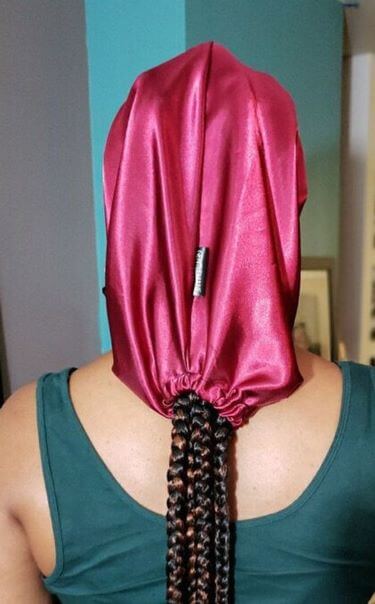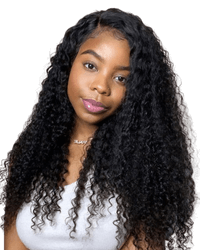When people are considering growing locs, it might be difficult for them to choose a starter loc style. Which starter locs best suit our hair texture and personality? How to make them by ourselves and grow them with proper maintenance?
After all, the starter locs journey is quite challenging for people without much experience. Further, we also need to know some tips to maintain start locs to get gorgeous results. Now, follow us to get 13 amazing starter locs styles for you to try on.
What Are Starter Locs
Starter locs, also called baby locs, are the first stage of a loc journey. It is a basic loc hairstyle before it grows into mature locs. And usually, this stage will last from 3 to 6 months depending on our hair type and hair maintenance.
There are five different loc stages during the whole loc process. It starts from the starter locs to the budding stage, teen stage, maturity stage, and the final rooted stage. To get a formed locs with all these phases will take about 1-2 years in total.
To know more about all the stages, check out the post.
Factors to Consider Before Starting Locs
There are many different methods to start locs. But before we have our starter locs journey, some factors need to be considered.
Hair length
Firstly, our hair length is a basic factor that might be our primary consideration. For example, some styles such as comb coils and sponges are better for short hair. While some styles such as two-strand twists and braids are fitter with longer hair.
Hair texture
Secondly, another important factor is hair texture. Coarser hair textures might be better for sponges or freeform locs, as they are easy to grow naturally. And the straighter, looser textures usually work better with two-strand twists or backcombing.
Parting pattern
Next comes the parting pattern. Different parting pattern contributes to creating different size locs and scalp coverage. Proper parting selection according to our locs size and style methods will avoid hair breakage for a long time.
Loc size
Lastly, the loc size also matters a lot. Large locs, medium locs, small locs and microlocs are the common sizes for locs. As the locs will get tighter and smaller, it is beneficial that we choose large or medium locs.
13 Starter Locs Styles You Should Have a Try
Which style you choose will largely depend on your hair texture and the end style you’re going for. But any of the following starter loc styles will grow to be a headful of beautiful locs.
You may decide to have cultivated sectioned locs, or you can go for a freeform look.
Two-strand twists
Two-strand twists are one of the most common styles to start with. It is a basic style that can combine with different variations of hairstyles.
To do two-strand twists, we should first divide hair into 6 horizontal sec. Then secure each section remaining separated with clips. Remove one clip to lose one section and divide it into 2 new sections.
Lastly, twist the 2 new sections over each other until the ends of our hair. Then we repeat the process for the remaining sections to get all the whole hair twits. And don’t forget to apply some cream or gel to lock in the style.
Comb coils
Another attractive starter locs style is the comb coils. Comb coils, also known as gel twists, are more fit for short hair. Unlike two-strand twists need about 4 inches, comb coils only need about 2 inches with any texture of hair.
Grabbing a small section of hair to start, then insert a teeth comb into the hair section. Use the comb to spin from root to tip to make hair strands form into coils. This style is easy to make with a simple comb and also takes less maintenance effort. We only need to keep hair coils moisturized during the process.
Sisterlocks method
Another common starter locs style is sisterlocks. Sisterlocks usually will look different from many other traditional starters locs. They are tiny microlocs that sometimes look like loose hairs.
To create the style, we will need a specific interlocking tool to make grid patterns. And it is usually suggested to install by a certified loctician or hair consultant. Furthermore, the installation process may range from 16-18 hours by several appointments.
However, it is worth spending time on this versatile style. Its tiny size allows us to fit with different locs lengths. People with these locs can also switch to another locs style easily.
Interlocking method
Interlock is a commonly used way for starter locs. The style itself has lots of flexibility that can be created with any hair texture or length. It is great for people who have fine hair that may harder to stay loc’d to use.
This method is done by using a crochet needle/latch hook. Wrapping a band around the end of a hair section, then pulling the ends of the hair through the roots by the needle.
Make sure that move the ends in the opposite direction like north to east, then south to west motion. It may take some time to get the hang of it, but the results are well worth the time and effort!
Freeform method
Next comes the easiest way to do starter locs, freeform locs. As its name shows, it is a natural and organic way to get locs without any tools or products requirement. In addition, it requires low maintenance for a long time.
People who have coarse hair with some curl can just stop brushing or detangle the hair. It will grow naturally to tangle the locs. People without coarse hair can palm roll o twist the locs sometimes.
With this wild freeform style, we can live our lives and allow our hair to do its own thing. The only demerit of this style is that it may form into locs over a long time.
Braids / Plait method
Another classic starter loc style is the braids /plait method. If you have long hair of about 5 inches with loose textures, then braids loc are a great alternative.
It is start by sectioning off the hair in a grid pattern. Then divide each section into 3 strands to make braid locs. To braid all the sections of the hair, may take a long time for this style.
However, the results are well worth the time and effort. As the braid locs are likely to stay together so it helps prevent the unraveling of the hair. Then it will be great if you want to wash to keep neat or may sweat a lot in the scalps.
Backcombing
If your hair is naturally straight or kind of weak, then backcombing might be a good option for you to pick. This method requires longer hair about 4-6 inches to start with.
Backcombing involves combing your hair backward with a fine-tooth comb. Once the hair is tangled by teasing, then can palm roll it into the shape of your desired locs. But some people may be more sensitive to pulling and tugging, and can just backcombing at the ends.
Backcombing is easy to maintain by palm rolling in the beginning stage. And it is a gentle method for fine or damaged hair problems.
Loc Extensions
One of the most flexible ways for any hair texture or length might be the loc extensions. Thanks to the development of loc extensions, we can experiment with any colors, textures, and lengths of them.
Choose the desired loc extensions according to your natural hair and events. And tie them off at the root and wrap them around each braid. Then you can get the final look you want right away.
However, there are some disadvantages of loc extensions such as it may be pricey to buy a good one. And need to take good care of it for long-term maintenance.
Palm Rolling
Palm rolling is another method that is easy to make for starter locs. It is similar to twisting and can undo easily till you feel it styled very well at home.
Instead of twisting with our fingertips, we roll sections of the hair between our palms. Then the strands will twist in our palms quickly and naturally form locs over time. Our palms will help to control the strands to form the size and shape of the loc as much as we want.
Besides, the whole possess is not painful at all as it is like giving yourself a massage. Palm rolling not only easy for maintaining locs but is also good for keeping them in good condition.
Sponge Method
The sponge is another method that is similar to freeform. It helps to develop ours locs naturally and gradually. For people with short hair or coarser hair textures, it might be the ideal way to go.
Firstly, we need to prepare a clean curl sponge or sponge brush. Then use the sponge to rub your hair over the ends in a small circular motion lightly. Make sure that maintain the motions in the same direction consistently.
Keep doing the motion bout 10-15 minutes every day for a couple of weeks. Then circular motions will develop your hair to form tiny coils. In the end, this sponge method will give you non-uniform and less-designed locs.
Instant Locs
Instant locs are perfect for people who have long straight or wavy hair. As the name shows, we can transform our look right away instead of waiting a long time to grow into mature locs.
Again, in this style, it requires a crochet hook to form our desired look. Firstly, section off the hair and twist the section. Then use a crochet hook in and out of the section to interlock your loose natural hairs into the proper shape.
The whole process usually only takes a couple of hours. But for some sensitive people, it might be a little uncomfortable.
Faux Locs
Faux locs are a great extension way for starter locs too. For people who want to get mature locs faster, faux locs are much less time-consuming.
To start with, we need to take a small section of hair and put a strand of braiding hair behind it. Then braid the center natural strand with the two synthetic strands into a rope braid. And keep adding more synthetic strands in the same way.
In the end braids, we can use a lighter to seal the end of the braid hair. Repeat the process with the remaining hair. Again, to get the faux locs it is also suggested to install by a loctician consult.
Goddess Locs
Goddess locs are super appealing start locs among the mass. The definition of goddess locs may vary from person to person. They can be considered a special type of faux locs with a sign of curly loose ends.
Goddess locks are usually achieved by loose braiding hair first. Then choose faux locs that match the color of the braiding hair to wrap around. But make sure that the faux loc won’t cover all of the braiding hair, but naturally blend into it.
The goddess locs are easier than general faux locs and worth trying out for beginners!
How to Maintain Starter Locs
No matter which method we chose to get our starter locs, there are some tips we need to learn to maintain the baby locs.
Don’t Washing Too Often
We may like to wash our natural hair several times a week, but it’s not very suggested for starter locs. It will lead to undoing our baby locs if you wash them in the early stages. So don’t overwash them until 3-4 weeks.
And when you wash them remember to do it carefully so that won’t disturb the delicate starter locs.

Don’t Deep Condition
Similar to washing suggestions, regular deep conditioning is also not very recommended. As it may ruin baby locs by making them too soft to form. It is sure that the soft locs will easily unravel especially in the still-forming period.
So make sure to choose lightweight conditioning to use instead of heavy ones.
Limit the Moisturizing
Moisture is essential for locs and scalps to keep healthy. But for starter locs, moisturizing will unravel locs during the formation stage. To avoid this, we’d better focus more on the roots part with lighter moisturizing products.
Furthermore, we can combine moisturizing with conditioning on a reasonable schedule.

Don’t Retwist the Locs Too Often
People tend to retwist the locs in their palms when they wash them. It is helpful to lock up them before they get mature once a month. But retwisting or rolling them too often will also lead to hair breakage and weaken roots over time.
Hair Products
For common hair maintenance, there are plenty of products to choose from. However, for starter locs, we should be careful to use and keep it simple.
So avoid some heavy products so that less product buildup in our budding locs. As once it is used, it may be hard to remove while our locs are growing with it. In this case, use natural oils and other water-soluble products in moderate amounts.

Separate The Roots
For freeform locs, it is not necessary to separate the roots during the formation period. But if choose to cultivate locs, then we should make sure they grow in the right direction.
Separating the roots can prevent the locs from retwisting in the wrong direction.
Sleeping and Activities
Starter locs tend to pick up lint from cotton pillowcases and it is harder to remove. So better to wear a satin cap or scarf while you are sleeping.
And some physical activities with heavy friction may lead to locs breakage too. We can wear some silk bands to protect our locs while having activities.

Avoid Excessive Manipulation
The starter locs are usually frail and easy to unravel, so make sure to avoid excessive manipulation. Remember they aren’t even formed yet! Keeping hands off of your locs at the beginning will help them natural shaping and grow healthy.
Avoid Tight Styling
In the end, the last thing to keep in mind is to avoid tight styling. As the pulling and stress on strands will lead to hair breakage, thin roots, and even irreversible damage.

Conclusion
There are various starter locs styles for us to choose to begin our locs journey. Choose the style that is proper for your hair and maintain them with the right methods. Cultivating your own special locs will be a very interesting journey!
Leave a comment to share your helpful ideas below.






